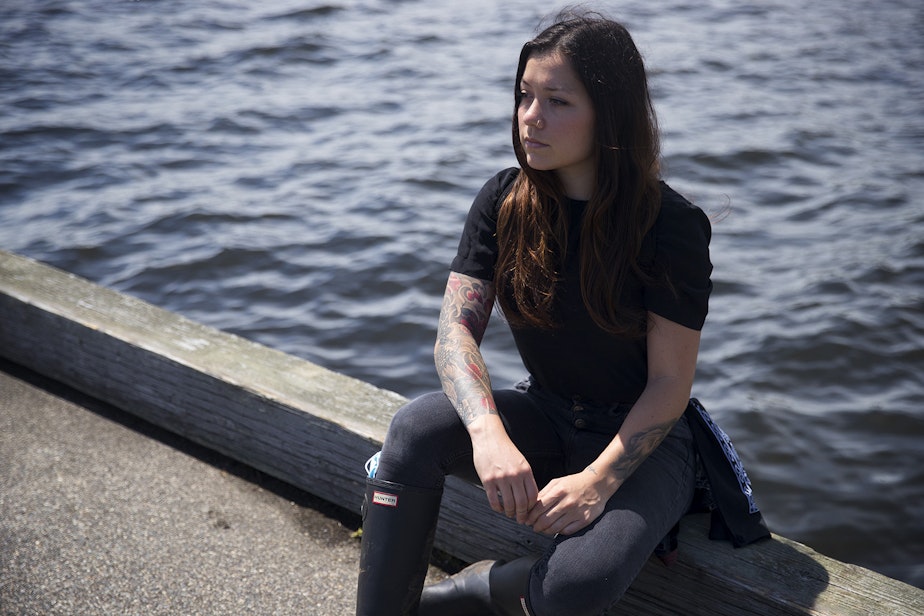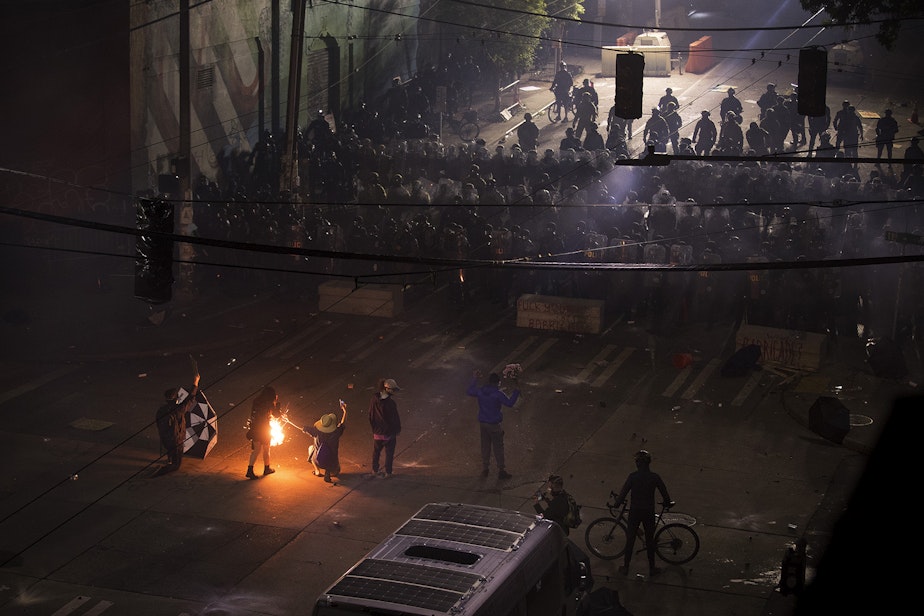This woman 'died three times' after Seattle Police hit her with a blast ball

On Sunday night, on the tenth day of protests for racial justice in Seattle, a petite young woman stood between protesters and a barricade of police.
She had long dark hair, and wore a blue flower-print dress with combat boots. She had attended almost every day of the protests, and here she was with four other protesters, standing as a buffer against a wall police in riot gear, three rows deep. As the protest grew louder, police repeatedly called for the crowd to move back.
And then BANG. The police had thrown a blast ball that hit her in the sternum. A fireball flared at her feet, nearly half her size. And then another flash, as smoke filled the air. She spun around, her hand covering her face. She collapsed, and screamed.
Later doctors would tell Aubreanna Inda, 26, that she died three times that night.

I
nda moved to Seattle from Colorado two years ago to study law.
George Floyd’s death was a political awakening for her. She had never joined a protest before.
“When I saw this video, in particular with George Floyd, it really brought me to tears,” Inda said. “I couldn’t stand to watch it. I couldn’t understand how the cops could possibly do that even while being filmed.”
Inda is Latina American, she said, and light-skinned.
Sponsored
“I’ve always been privileged not to have to experience any sort of suffering,” she said. But that came at a price, too. She said her dad, who’s Mexican, shielded her from his roots and tried to raise her mostly white. “That's pretty sad that you have to hide your heritage from the world,” she said.
On the first day of the protests, Inda attended with friends. A National Guard soldier hit her in the back with a baton, she said, and she had difficulty staying upright. She feared she would be trampled. It was dangerous, but she vowed to return.
From that day on, she attended the protests with new friends she met, with her dog, or sometimes alone.
“I started talking to other people and organizers, and wanting to just meet people that are just as passionate about the situation,” she said. She made friends, she volunteered handing out water and food, and learned more about racism and police violence.
“I just had to get out there no matter what,” she said.
Sponsored
On that Sunday, around 10 p.m., Inda could feel the tension rising between police and protesters.
“I told my friends that I was gonna go up to the front of the line and see if I could diffuse the situation,” she said. She had grown up liking police, gotten stickers from them as a kid, and believed she could convince them to empathize with the protesters.
She tried speaking with them, but “it wasn’t going through,” she said. She said she knew there were people under those uniforms, and that the protesters were people too.
“I thought originally that police are supposed to be the peacemakers; they are the neighborhood watch,” Inda said. “They are the people that we are supposed to go to when in dangerous situations. And now we can't do that.”
She asked them who they were fighting for.
Sponsored
“They would just say ‘Seattle government, and not for you,’” Inda said. “That’s kind of hurtful, because aren’t they supposed to be working to protect us?”
Her words had no impact. Using a loudspeaker, police told protesters to retreat.
Inda and the three other protesters at the front began to kneel, and put their hands in the air.
“As I was about to get on my knees, I was shot in the chest with a flash grenade and I had another flash grenade go off at my feet,” she said.
Protesters closed in around and helped lift her off the ground, out of the fray. She was hyperventilating.
“I got the wind knocked out of me completely,” Inda said. “I couldn't hear anything. My ears were ringing, and after that I just completely blacked out.”
Photo and video footage from that night show her roughly 25 feet from the police line when she was hit at 12:10 a.m. One minute later, SPD tweeted: “The crowd is throwing bottles, rocks, fireworks, and other projectiles at officers. The crowd is shining green lasers into officers' eyes. Officers are responding with OC Spray and blast balls.”
Police continued to advance on the crowd. Street medics put Inda on a cot, running to get her to safety.
She lost consciousness, and didn’t have a pulse. Someone started chest compressions to bring her back to life. Inda opened her eyes briefly, but closed them shut because they felt like they were on fire from the pepper spray.
A medic called 911 but it would take too long for an ambulance to reach them through the havoc and blocked streets. A friend drove her and a medic to Virginia Mason hospital, where medical staff continued performing CPR.
“I just remember looking up and seeing a lot of doctors and hearing their voices, saying that I was losing pulse again,” Inda said.
To them, she was Jane Doe. She didn’t have her ID on her; her backpack had been left near the medic tent.
The next morning, Inda woke up with a tube down her throat, and a doctor walking in, asking her for her name.
The doctor told her that if the street medics hadn’t helped her on Sunday night, she might not be alive. She’d undergone cardiac arrest on the street, and then again in the hospital.
Inda was discharged from the hospital on Monday, although doctors advised her to stay an extra day. She wanted to be home. On Tuesday evening, she said her throat feels scratchy, and she tires easily.
“I can't walk too much,” she said. “If I stand for a long period of time, I have a really hard time breathing. I feel like someone is stepping on my chest.”
She’s had vertigo. Noises sound louder than usual, and when she closes her eyes she sees “the cops’ shields in my face.”
Inda said she would return to the demonstrations.
“I don't want people to continue getting hurt, she said. “A lot of lives have been taken by cops and we are still fighting for those people.”
“The cops can shoot me in the heart and cause it to stop, but it's not ever going to stop for this protest.”
A Seattle police spokesman said "all uses of force are under investigation." This case would be investigated and possibly forwarded to the department's Force Investigations Team.
Seattle Police Tweets from Sunday night:
11:48 p.m. Incident Commander issued another warning to demonstrators to move back after someone in the crowd threw a glass bottle toward the officers, striking a @WANationalGuard member in the head. Unknown injury.
12:07 a.m. Incident Commander has issued two dispersal orders, demonstrators should leave the area now.
12:11 a.m. The crowd is throwing bottles, rocks, fireworks, and other projectiles at officers. The crowd is shining green lasers into officers' eyes. Officers are responding with OC Spray and blast balls.
12:18 a.m. The officers are taking heavy projectiles, coming from the crowd. A male, armed with a gun is in the intersection of 11th and Pine ST. CS gas has been authorized. In the interest of public and life safety, leave the area now.
12:34 a.m. Another dispersal order was given. The crowd is still throwing projectiles and fireworks at officers.


